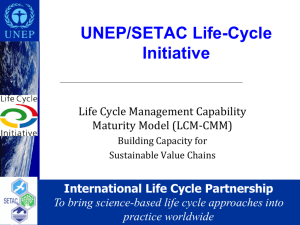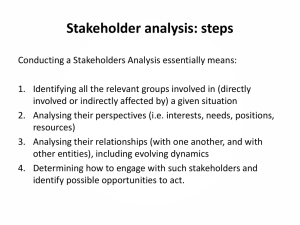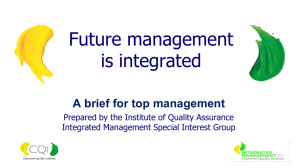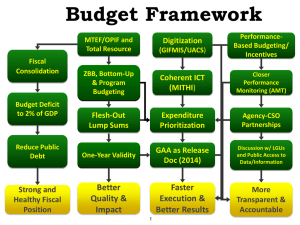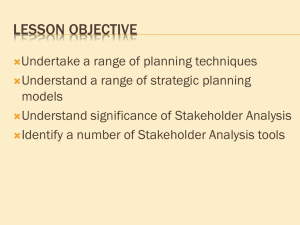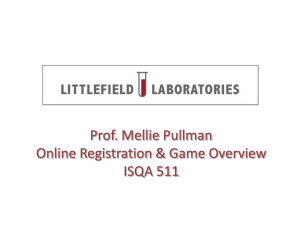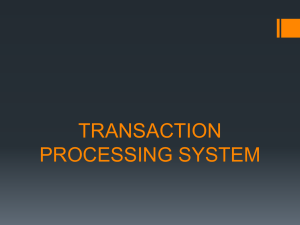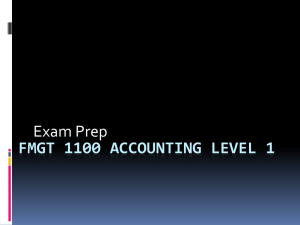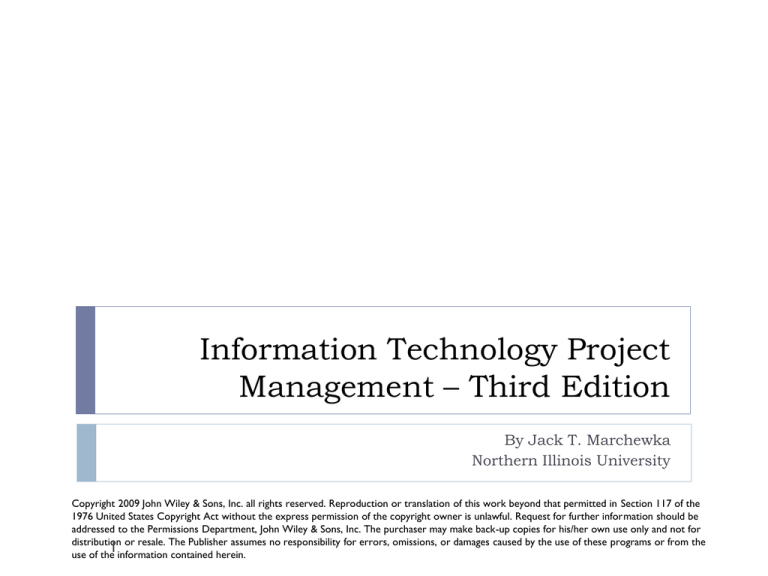
Information Technology Project
Management – Third Edition
By Jack T. Marchewka
Northern Illinois University
Copyright 2009 John Wiley & Sons, Inc. all rights reserved. Reproduction or translation of this work beyond that permitted in Section 117 of the
1976 United States Copyright Act without the express permission of the copyright owner is unlawful. Request for further information should be
addressed to the Permissions Department, John Wiley & Sons, Inc. The purchaser may make back-up copies for his/her own use only and not for
distribution or resale. The Publisher assumes no responsibility for errors, omissions, or damages caused by the use of these programs or from the
1
use of the information contained herein.
The Human Side of Project
Management
Chapter 4
2
PMBOK® Area – Project Human
Resources Management
Human Resources Planning
Acquiring Project Team
Putting together a project team with the right mix of skills and
experiences
Developing Project Team
Creating a staff management plan that identifies project roles,
responsibilities, and reporting relationships
The technical, organizational, and interpersonal skills of team members
may need to be augmented through training
Also includes creating the team environment
Managing the Project Team
The challenge of managing local and/or geographically dispersed project
team members
3
The Formal Organization
Formal groupings & specializations
Documented in an organizational chart to clarify and portray the
lines of authority, communication, reporting relationships and
responsibilities of individuals and groups within the organization
Indicates how a project will interface with the parent organization
Determines how resources will be allocated, who has authority
over those resources and who is really in charge of the project
Published Lines of
Authority
Responsibilities
Reporting Relationships
Communication
Decision-Making
4
Organization and Project Planning
Organizational Structure
Figure 4.1
5
The Functional Organization
Figure 4.2
6
The Functional Organization
Advantages
Increased Flexibility
Breadth & Depth of
Knowledge &
Experience
Less Duplication
Disadvantages
Determining Authority
& Responsibility when
project crosses
functional areas
Poor Response Time –
multiple layers of
management
Poor Integration –
functional areas isolate
themselves (silos)
7
The Project
Organization
8
The Project-Based Organization
Advantages
Clear Authority &
Responsibility
Improved
Communication
High Level of
Integration – better
communication across
the org
Disadvantages
Project Isolation from
other projects
Duplication of Effort
“Projectitis” – team
becomes to attached to
project and may not
want to kill it
9
The Matrix Organization
Figure 4.4
10
The Matrix Organization
Hybrid organizations
Balanced matrix – project manager defines activities,
functional manager carries them out
Functional matrix – PM coordinates project activities, FM
completes activities related to their area
Project matrix – PM has most of the authority and
responsibility for defining and completing the project
activities while the FMs provide guidance and resources
11
The Matrix Organization
Advantages
High Level of
Integration
Improved
Communication
Increased Project Focus
Disadvantages
Potential for conflict
Unity of Command can
be violated, more than
one boss
Poor Response Time
12
Which Works Best
A study of 1,600+ project management professional by Larson and
Gobeli concluded
Both project managers and functional managers have a strong preference
for the project or project matrix organization
Functional and functional matrix were seen as the least effective
Balanced matrix was seen as only marginally effective
Functional organization may work best when only a few internal
projects are being worked on or for a project undertaken within one
specific area of the organization
An organization with a large number of external projects
would find project organization a better structure
Projects that require a cross-functional approach or have limited staff
would be better suited to a matrix organization
13
The Formal Organization
The formal organization is the published structure that
defines the official lines of authority, responsibilities
and reporting relationships
While the formal organizational structure tells us how
individuals or groups within an organization should
relate to one another, it does not tell us how they
actually relate.
14
The Informal Organization
Bypasses formal lines of communication & authority
Communication can be much faster than in a formal
organization
Power is determined by how well one is connected
in the informal network – i.e., the “grapevine”
Can be more complex than the formal organization
because relationships are established from positive
and negative relationships over time
15
Stakeholders
Individuals, groups, or even
organizations that have a “stake”
or claim in the project’s (successful
or unsuccessful) outcome
16
Stakeholder Analysis Process
Develop a list of stakeholders who have an
interest in the successful or unsuccessful outcome
of the project
Identify the stakeholder’s interest in the project
1.
2.
3.
“+1” for positive interest
“0” for neutral
“-1” for negative interest
Determine the degree of influence each stakeholder
has on a scale of 0 (no influence) to 10 (can terminate
the project)
17
Stakeholder Analysis
4.
5.
6.
7.
Assessing potential conflict among the stakeholders –
i.e., one stakeholder may want to increase system
functionality which will increase the budget and time
while other stakeholders may want to limit the
budget
Define a role for each stakeholder – e.g., champion,
consultant, decision maker, ally, rival, foe, etc.
Identify an objective for each stakeholder – e.g.,
provide resources, guidance, expertise, acceptance,
approval, etc.
Identify a strategy for each stakeholder – e.g., build,
maintain, improve, re-establish the relationship
18
Stakeholder
Interest
Influence
Potential
Conflicts
Role
Hirem N. Firem
+1
5
Competition for resources
with other functional
managers
Project Sponsor
and Champion
Provide
resources,
approvals,
and public
support for
the project
To maintain ope
communication
so that political
landmines can b
avoided
Dee Manitger
+1
3
Resources not made available
as promised by functional
managers
Project Manager
Lead and
manage the
project so
that it
achieves its
MOV
Work closely
with project
stakeholders an
project team
Project Team
+1
2
This project will change a
number business processes.
Affected users may resist
change by withholding
information
Steve Turner –
Network
Administrator
Shedelle Bivits –
Systems Analyst
Corean Jenkins –
Programmer/DBA
Myra Dickens –
Inventory Analyst
Provide
expertise to
complete the
project work
Support project
team with
adequate
resources while
minimizing
distractions
I.Will Sellit
-1
4
As the marketing manager,
Sellit is not pleased that this
project was chosen over his
proposed project. May
withhold promised resources
Build and
maintain best
possible
relationship
to minimize
attempts to
divert
resources
Maintain open
communication.
Use project
sponsor’s
influence as
necessary
Foe
Objective
Strategy
19
The Project Team
The Roles of the Project Manager
Managerial role – planning, organizing, controlling,
administrating
Leadership role – build and nurture the relationship among
stakeholders, motivate the team, focus everyone on same goal
Attributes of a successful project manager
ability to communicate with people
ability to deal with people
ability to create and sustain relationships
ability to organize
20
Team Leader (Project Manager)
Acts To:
Clarify purpose & goals
Build commitment & self confidence
Strengthen team’s collective skills
Remove external obstacles
Create opportunities for others
Creates the Project Environment
Work space
Team culture and values
Project administration
Ethical Conduct
21
Team Selection
The PM must find the right mix of people with both
technical and nontechnical skills
Some of the skills to look for
Technology skills
Business/organization skills – domain/industry knowledge
Interpersonal skills
Timing of hiring can impact the success of a project
22
The Wisdom of Teams
Jon R. Katzenbach Douglas K. Smith
Provides insights to understanding the language
and discipline of teams
Work Groups
Pseudo Teams
Potential Teams
Real Teams
High Performance Teams
23
Work Groups
Single leader in control making most of the decisions,
delegates to subordinates and monitors the team’s
progress
Members interact to share information, best practices, or
ideas
No shared performance goals (individual performance)
No joint work-products
No mutual accountability
Viable in many situations
e.g., study group
24
Teams
Bring complementary skills & experience
Jointly defined clear goals & approaches
improve communication
Improve decision-making
Have more fun
25
Real Teams
Small number of people (2 -12)
Complementary skills
Committed to a common purpose and performance
goals
People understand how their joint work impacts the
organization
Common approach how to work together
technical, interpersonal, decision making, etc.
Open communication and trust leads to sharing of ideas and
skills so team members can learn from one another
Hold themselves mutually accountable, not individual
accountability
26
Example of a Project Team Charter
Figure 4.10
27
A Learning Cycle Approach to
Project Management
An Agile Project Management Approach
28
Learning Cycles
Derived from
educator/philosopher John
Dewey (1938)
Used to describe how
people learn (Kolb, 1984;
Honey & Mumford, 1994)
Can be applied to project
teams (Jeris, 1997; Redding,
2000).
29
Traditional Teams
Accept background information at “face-value”
Approach projects in logical, linear fashion
Provide run-of-the-mill solutions
Solutions remain within the original “frame” or how the
problem was originally presented to them
30
Radical Teams
Do not accept issues & tasks at their “face value”
The way the problem is defined may very well be the
problem
Unquestioned assumptions are surfaced & challenged
Only by digging below the surface can we get to the
“root” so that a meaningful solution can emerge
31
A Learning Cycle
Figure 4.6
32
Example of a Team Learning Record
What we know
(Facts)
What we think we know
(Assumptions)
What we don’t know
(Questions to be
Answered)
Company has too much
inventory on hand
It may be an efficiency
problem
Cost of maintaining current
inventory is becoming
prohibitive
Management believes an new What are the current levels
information system will
of inventory?
improve efficiency and
therefore lower inventory
levels
Inventory turnover needs to
be increased
Figure 4.7
Why are inventory levels so
high?
What is the desired level of
inventory?
33
An Example of an Action Plan for Team
Learning
Who?
Does What?
By When?
Shedelle and Steve
Interview sales team to
understand past, current, and
future trends for the company’s
product.
Tuesday
Myra
Provide a detailed count of the
current physical inventory on
hand.
Thursday
Research potential inventory
management system commercial
packages
Thursday
Corean
Steve
Figure 4.8
Research average inventory
levels for the industry
Wednesday
34
Team Learning Cycles over the Project
Life Cycle
Each cycle provides
the opportunity to
challenge framing assumptions,
create new understanding &
find radical solutions
Figure 4.9
35

